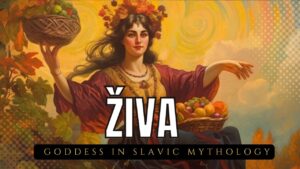Goddess Ziva has been around for a very long time. The name of the goddess comes from North Africa. But the closer we get to ancient times, the more she stands out, both as a goddess and as life itself. Iva is a word used in Slavic languages to mean “life” or “living.” The goddess Iva was very important to the Slavic Polabians, especially the Bodrici (Mecklenburg). She was also important in Slovakia. She has been called Shiwa, Syeba, and Dsiva in the past, but her name is most often written as Siwa. The Polabians thought she was the most important female god. She was a goddess of love and birth. Toma Linhart, a scholar from Slovenia who lived in the 1800s, says that the Palians believed in Shiva, who was called the goddess of life. Venus has this name because of the Raniolans. Z iva was the most important god of water. People thought of her as the idea of life, personified by water. It was she who was their first “goddess,” long before Mother Nature took over after farming began.
A strong stream called Aqua Siwa breaks the surface on the island. There is a spa here now. Stories from other Middle Eastern countries from the time of Veneti talk about the goddess Iva. In mythology from Slovakia, she is known as ivena. A chronicler named Helmold calls Iva Polabian a “goddess,” but he doesn’t say anything else about her. The same goes for other chroniclers. The picture of her didn’t appear in the second version of his history book until 1659. It’s clear that the flow of fresh water, which is the source of all life, was a sign of the goddess Ishtar. Her shape, which can’t be shown in its real form, is more than just a woman. It stands for life and its rebirth, as well as youth, beauty, and tenderness. All of those things that later goddesses of love, like Aphrodite in Greek mythology and Venus in Roman mythology, only partly show.
People had forgotten about Goddess Iva, but her picture and meaning live on in folklore in many forms. Some records talk about “living water,” which was sometimes a place to worship iva, the god of life, either directly or through its name. Fata is a young goddess in Oglej who tells the future and has something to do with births. It’s likely that the worship of Fata is really about iva. Like many other Celtic gods, she seems to have been taken up by the Romans and changed her name to Fata, which means “barbaric.” Several writings that have been found show this.
There are no clear records of how much her Polish name, Iva, was linked to the idea that women should be beautiful and have children. It’s clear that she was an important goddess because a church was built on the hill in Ratibor where her temple used to be. It is not known if she was worshiped in Carantania. Slovene scholar Linhart, on the other hand, says that Shiva is the goddess of life. The Ranilian people honor her with this name, but the Polabians called her Venus. The record kept by Linhart is very important if we want to know more about her role in the Carantanian religion before Christianity.
As far back as people can remember, the temple that stood on the Isle of Bled before the church was dedicated to Iva. Archaeologists who have worked on the island since World War II have dug under the church and found older foundations. During the time when people became Christians in the eighth century, one of them was the base that held up a square log house. At the back of it was a square building from the 9th century with an apse. This proved that Oglej had an effect on the area. The foundations of both buildings show how they changed from a pagan “harm” to an early Christian church with the help of stones. Did people pray to the goddess Isis at the pagan monastery? The need to worship pagan gods was constantly changed by Christian missionaries into worshiping the Mother of All. The church on Lake Bled is called Mary’s Ascension.
France Preeren, a poet from Slovenia, wrote the epic Baptism on Savica in the 1800s. It was about the Iva temple on the island of Bled and the shore of the Savica River. Those who believe in customs where water is important also remember the goddess of water and life. Girls around Ljutomer give gifts to the water on the last day of the year. To do something else, you have to throw a red apple into spring before it gets light. Heinrich Bangert wrote Helmold’s Chronicle, which came out in 1639. In it, Iva is shown with an apple in each hand. This means that the apple was also a sign of the goddess’ love in the folk stories of the Palebian people.
Iva, the old goddess of water, fertility, and love, was still a part of Slovenian folklore, but the name of the pagan goddess has been lost because of Christianity. But in Slovenian folklore, she lives on in stories and myths about the white woman, the washerwoman, or the god’s lady. She is also remembered in holiday traditions that center around wells and springs.






